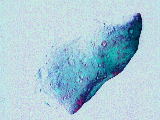In 1991 the Galileo spacecraft photographed the asteroid, Gaspra. This picture shows the asteroid in false color. Gaspra circles the Sun between Mars and Jupiter.
Click on image for full size
NASA/JPL
Japan And U.S. Join Together for Asteroid Expedition
News story originally written on June 20, 1997
The first asteroid collection mission has been set. Japan and the United States will join together in the MUSES-C mission. The mission is to be launched in January 2002 from Japan. The spacecraft will arrive at the NEREUS asteroid in September 2003.
Nereus is a small asteroid one mile across. It was discovered in 1982. At its closest point to the Sun, its orbit takes it just inside the orbit of the Earth.
The MUSES-C spacecraft contains a small robotic rover that will conduct surface measurements of the rocky asteroid. The rover weighs less than 2.2 pounds. It is the smallest rover ever flown in space. Samples will be taken from the asteroid to be brought back to earth.
Scientists can do experiments with these samples. The scientists hope to find information about how our solar system formed long ago.
You might also be interested in:

It was another exciting and frustrating year for the space science program. It seemed that every step forward led to one backwards. Either way, NASA led the way to a great century of discovery. Unfortunately,
...more
The Space Shuttle Discovery lifted off from Kennedy Space Center on October 29th at 2:19 p.m. EST. The weather was great as Discovery took 8 1/2 minutes to reach orbit. This was the United States' 123rd
...more
A moon was discovered orbiting the asteroid, Eugenia. This is only the second time in history that a satellite has been seen circling an asteroid. A special mirror allowed scientists to find the moon
...more
Will Russia ever put the service module for the International Space Station in space? NASA officials want an answer from the Russian government. The necessary service module is currently waiting to be
...more
A coronal mass ejection (CME) happened on the Sun early last month. The material that was thrown out from this explosion passed the ACE spacecraft. The SWICS instrument on ACE has produced a new and very
...more
J.S. Maini of the Canadian Forest Service called forests the "heart and lungs of the world." This is because forests filter air and water pollution, absorb carbon dioxide, release oxygen, and maintain
...more
In late April through mid-May 2002, all five naked-eye planets are visible at the same time in the night sky! This is includes Mercury which is generally very hard to see. You won't want to miss this!
...more















